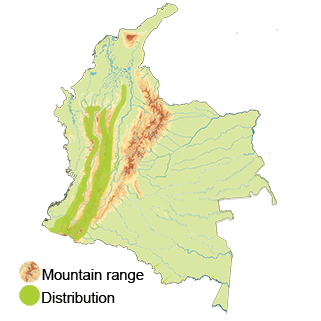Choco Daggerbill
The Chocó Daggerbill (Schistes albogularis) is a hummingbird species found primarily in the Chocó region of western Colombia.
Appearance: The Chocó Daggerbill is a medium-sized hummingbird with a curved beak that gives it its name. It has iridescent green upperparts, a white belly, and a bright rufous tail. This species exhibits sexual dimorphism, with males having more vibrant colors and longer tail feathers than females.
Habitat: The Chocó Daggerbill is found in the humid and montane forests of the Chocó region in western Colombia. It prefers dense forested areas with abundant flowers for feeding and suitable nesting sites.
Behavior: Chocó Daggerbills are known for their active foraging behavior, where they feed on nectar from flowers using their specialized beak. They may also feed on small insects and spiders, supplementing their diet with protein. These hummingbirds are agile flyers and can hover in place or dart swiftly among the forest vegetation.
Breeding: The breeding biology of the Chocó Daggerbill is not well-documented due to the remote and inaccessible nature of their habitat. They are believed to build small cup-shaped nests using plant fibers, spider silk, and other materials. Breeding is timed with the availability of resources for raising offspring, such as abundant nectar and insects.
Conservation Status: The Chocó Daggerbill is classified as Near Threatened by the International Union for Conservation of Nature (IUCN) due to habitat loss and degradation in its range.
Distribution
The Chocó Daggerbill (Schistes albogularis) is primarily found in the Chocó biogeographic region of western Colombia.
Pacific Coast: The Chocó Daggerbill is commonly found along the Pacific coast of Colombia within the Chocó Department. This area is characterized by lush rainforests, high levels of rainfall, and high biodiversity, making it a suitable habitat for this hummingbird species.
Chocó Region: The Chocó Daggerbill is specifically associated with the Chocó bioregion, which extends from western Panama through Colombia to northwestern Ecuador. This region is known for its exceptionally high levels of endemic species and biodiversity, including a variety of unique flora and fauna.
Western and Central Andes: The Chocó Daggerbill can also be found in the western and central flank of the Colombian Andes.
Taxonomy
The Chocó Daggerbill (Schistes albogularis)
- Kingdom: Animalia
- Phylum: Chordata
- Class: Aves (Birds)
- Order: Caprimulgiformes
- Family: Trochilidae
- Genus: Schistes
- Species: Schistes albogularis
Vocalization
The Choco Daggerbill uses its vocalizations for various purposes essential to its survival and reproduction.
- Communication: Vocalizations are used by Choco Daggerbills to communicate with other members of their species. This includes maintaining contact with their mate, offspring, or other group members. They can convey information about their location, movements, and even food sources through their calls.
- Territorial Defense: Choco Daggerbills use vocalizations to define and defend their territory from intruders. Their calls can serve as a warning to other birds to stay away from their established feeding or breeding areas.
- Mate Attraction and Courtship: Vocalizations play a crucial role in attracting mates and courtship rituals. Male Choco Daggerbills may engage in elaborate singing and calling displays to impress females and establish their suitability as a mate.
- Warning Signals: The Choco Daggerbill uses different vocalizations to alert nearby birds of potential threats or predators in the vicinity. This helps to mobilize group members to take evasive actions and ensure overall safety.
- Parent-Offspring Communication: Vocalizations are also important in parent-offspring interactions. Choco Daggerbill parents use specific calls to communicate with their chicks, ensuring their care, feeding, and protection.





